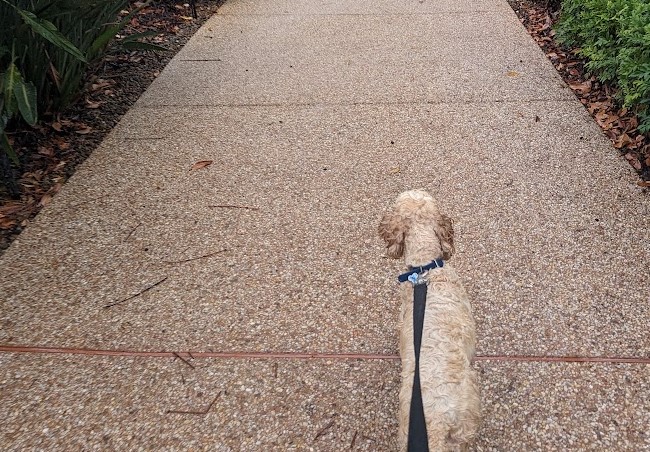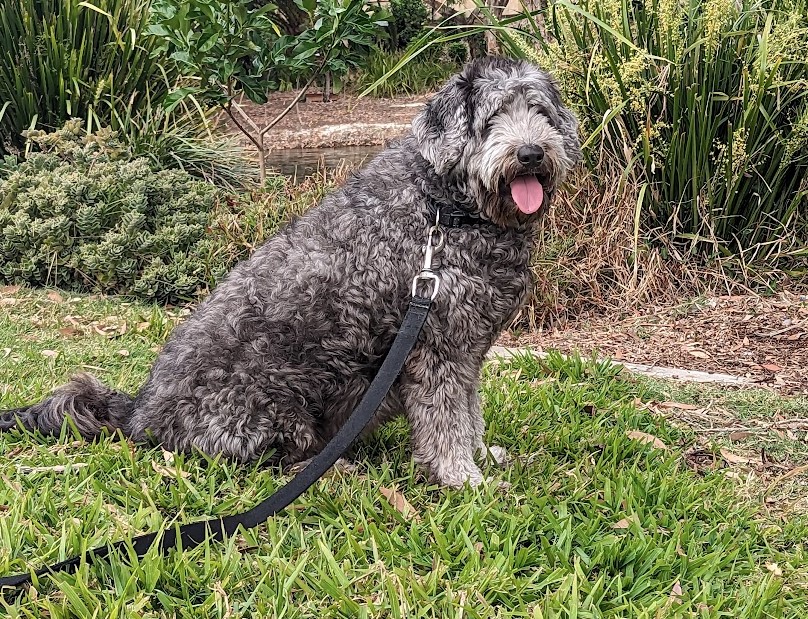Hey, fellow dog lovers, Mel here from All For Furry Friends, nestled right in the heart of the beautiful Gold Coast. As someone who’s devoted their life to the wellbeing of our furry companions, I’ve learned a thing or two about the art and science of dog walking. It’s not just a job for me; it’s a passion that fuels my day, every day. And in this space, I want to share some of that passion and knowledge with you, especially when it comes to answering a question as crucial as “How long should you walk your dog?”

Now, you might think the answer is straightforward, but as any experienced dog walker or owner will tell you, it’s a bit more nuanced than that. The truth is, the ideal duration for your dog’s walk can be as varied as their breeds, personalities, and the wag in their tail. From pint-sized pooches to gentle giants, energetic puppies to wise old dogs, each has its own set of needs that we need to consider.
For the average small to medium-sized, healthy dog, I usually recommend around an hour of walking time. But let’s be clear: this isn’t a one-size-fits-all solution. Factors like age, health, and the individual quirks of your dog can add layers of complexity to this seemingly simple routine. And if you’re dealing with a furry friend who’s either bounding with youthful energy or one that’s moving at a more ‘senior’ pace, the rules of the game change again.
But before we delve deeper, let’s not forget why we’re doing this. Walking our dogs is about more than just physical exercise; it’s about bonding, mental stimulation, and ensuring they live a life brimming with happiness and health. So, as we trot through the nuances of dog walking together, remember, at All For Furry Friends, we don’t just believe in walking your dog. We believe in walking them right.
Understanding Your Dog’s Needs
Embarking on our daily walks with our canine companions is more than a routine; it’s a journey we share that’s full of health benefits and mutual enjoyment. But how do we gauge the perfect amount of time for each walk? It’s a bit like crafting a bespoke suit; it has to fit just right, taking into account several crucial measurements.

Let’s start with size – it often plays a starring role in the walking script. A Great Dane’s stride is leagues apart from a Chihuahua’s trot. While size can be a starting point, it’s far from the whole story. A robust medium-sized bulldog might require less exercise than a tiny but energetic Jack Russell Terrier. So, while we have general guidelines, we tailor them to each dog’s unique needs.
Age is the next scene-stealer. Just like us, dogs’ needs change as they grow and age. Puppies are bundles of energy but also have growing bones and joints that we must protect. Older dogs, in their prime, might crave longer, more vigorous adventures, while our senior furry friends may appreciate a leisurely stroll and more time to sniff the roses – or whatever else catches their fancy.
Then there’s dog’s health – the subplot that can turn the main story on its head. A healthy dog can stride through life with vigor, but when illness or injury enters the stage, it demands a script rewrite. Sometimes, a quiet amble is all they can handle, and other times; they may need to forego the walk all together in favor of rest.
The One-Hour Rule for Small to Medium Healthy Dogs
Now, about that one-hour rule—it’s like the golden hour for photography; it just seems to give us that perfect balance most of the time. But why one hour, you might ask? For our sprightly small to medium-sized pooches in the prime of their health, this timeframe hits a sweet spot between exertion and enjoyment, offering ample time for physical activity, mental stimulation, and sniffing—their way of reading the daily news.

Picture this: The hour starts with a brisk walk, where your pup’s paws patter alongside you, their nose twitching as they take in the scents and sights of the Gold Coast’s diverse landscape. It’s cardiovascular, it’s energizing, and it sets the tone. As we move into the middle of the session, there might be moments of play—fetch, tug, or just a good, old-fashioned run around in an open space. This keeps their muscles engaged and their reflexes sharp.
And then, as we wind down, we take it to a leisurely pace, allowing for exploration and those all-important sniffs. This last part is as crucial as the first; it’s their chance to decompress, process the stimuli, and just enjoy being a dog.
But an hour is not about watching the clock—it’s about reading the dog. Some days, your dog will be bursting with energy, and that hour will fly by. On other days, they might signal that they’ve had enough well before the hour is up. It’s my job—and the joy of any dog owner—to notice these signals.
Special Considerations for Puppies and Adolescent Dogs
When it comes to our littlest four-legged friends, the rules of the walking game are rewritten. Puppies and younger dogs are like sponges, soaking up every experience and bursting with boundless energy that seems to defy the laws of physics. Yet, despite their seemingly inexhaustible zest for life, we need to remember they are still developing, both physically and mentally.
Puppies, in particular, are a special chapter in the dog walking story. Their walks are less about the physical exertion and more about discovery and socialization. It’s their time to learn about the world around them, to meet new people and fellow pups, and to start understanding how to interact with their environment. The duration of their frequent walks needs to be shorter to prevent overtaxing their developing bones and joints. We aim for several short walks interspersed with plenty of play and rest, rather than a single long outing.
Senior dogs, often ranging from six months to eighteen months old (depending on the dog’s breed), may seem ready to take on the world, but they’re still maturing. They’re like teenagers, often pushing boundaries and filled with energy one minute, and then suddenly growing tired the next. Their walks can be longer than those of puppies, but still, we need to be mindful of their growing bodies. It’s also a prime time for training, so incorporating learning into their walks — like practicing heel work or recall — is as important as the physical exercise itself.
At All For Furry Friends on the Gold Coast, we pay special attention to these youngsters. For them, every alley is an adventure, every tree a potential new friend, and every gust of wind a mystery to be solved. We balance their need for stimulation with plenty of opportunities for rest, and always keep an eye out for signs of fatigue.
Behavioral Signs to Watch For
Just like us, our canine friends have their own ways of telling us how they’re feeling – it’s a conversation without words, where their behavior speaks volumes. Knowing what to look for can help us understand when they’re loving their dog walks, and when they might need a change in routine.
- Signs of a Happy, Healthy Walker:
- Eager anticipation: The sight of their leash or the mention of a walk should bring about a happy response. A wagging tail, excited barking, or an attentive posture are all green lights.
- Consistent pace: A dog that’s enjoying their walk will maintain a good, steady pace. They’re engaged, sniffing around, and exploring, but not pulling excessively on their leash.
- Responsive to commands: A dog that’s mentally stimulated and happy will be more likely to listen and respond to commands during a walk.
- Signs Your Dog May Need a Break or Change:
- Lagging behind: If your dog is frequently dragging behind, it could be a sign they’re tired or not feeling well. It might also reflect disinterest, particularly if the walk is too routine and predictable.
- Excessive panting: Some panting is normal, especially on warm days or after a playful sprint. However, if your dog is panting heavily and seems lethargic, it’s time to slow down or head home.
- Lack of enthusiasm: If your dog seems indifferent about walks or hesitant to start, it might be time to vary the routine. This could also be a sign of an underlying issue, so keep a close eye on them.
- Behavioral Changes That Require Attention:
- Sudden stops: If your dog frequently stops walking and refuses to move, they might be telling you something’s wrong. It could be as simple as an uncomfortable pebble in their paw or as serious as a joint issue.
- Whining or growling: Vocalizations like whining, growling, or yipping during a walk can indicate discomfort or pain. Pay attention to when and where this occurs to help pinpoint the problem.
- Change in posture: A dog in discomfort may hunch their back, lower their head, or refuse to put weight on a limb. Any persistent change in posture should be addressed.
Conclusion
As I often say here at All For Furry Friends, every dog walk is a tale of tails, each one unique and each one important. Over the years, strolling along the stunning vistas of the Gold Coast, I’ve come to realize that there’s no one-size-fits-all answer to the question, “How long should you walk your dog?” But through understanding, patience, and attention, we can tailor the perfect walking experience for each furry individual.
For our vibrant small to medium-sized companions in good health, aiming for that one-hour mark is a solid guideline that can be adjusted based on the vibrant signs they give us. Whether it’s the joyous bounce in their step or the occasional need for a slower pace, our adult dogs communicate their needs in a language all their own. It’s up to us, as their trusted human companions, to learn that language.
For young pups and adolescents, walks are a patchwork of short, frequent, and richly varied experiences that cater to their developmental needs, filled with new sights, sounds, and smells. Throughout a dog’s life, we must remain vigilant, reading the subtle cues that signal their pleasure or indicate when it’s time to take it easy.




